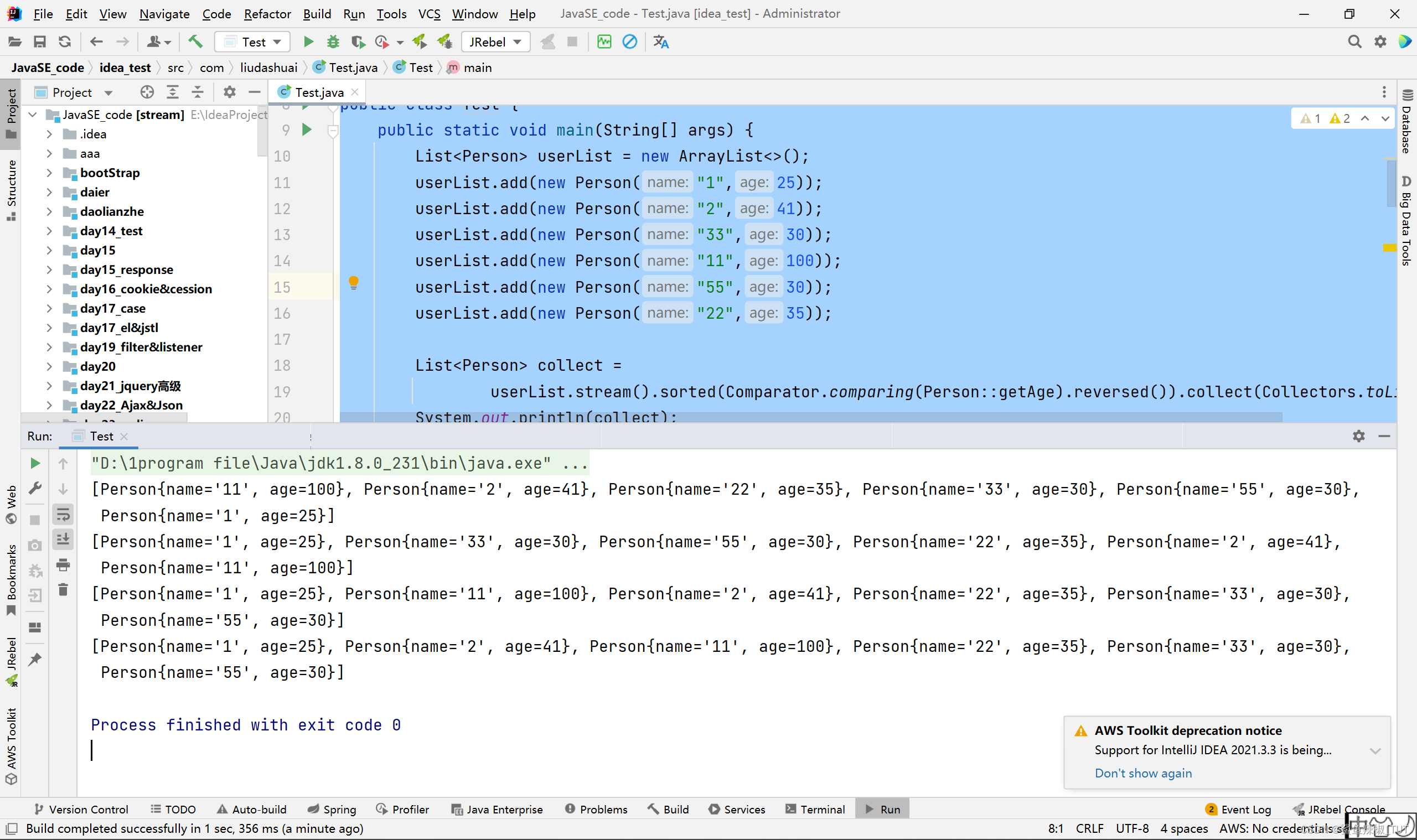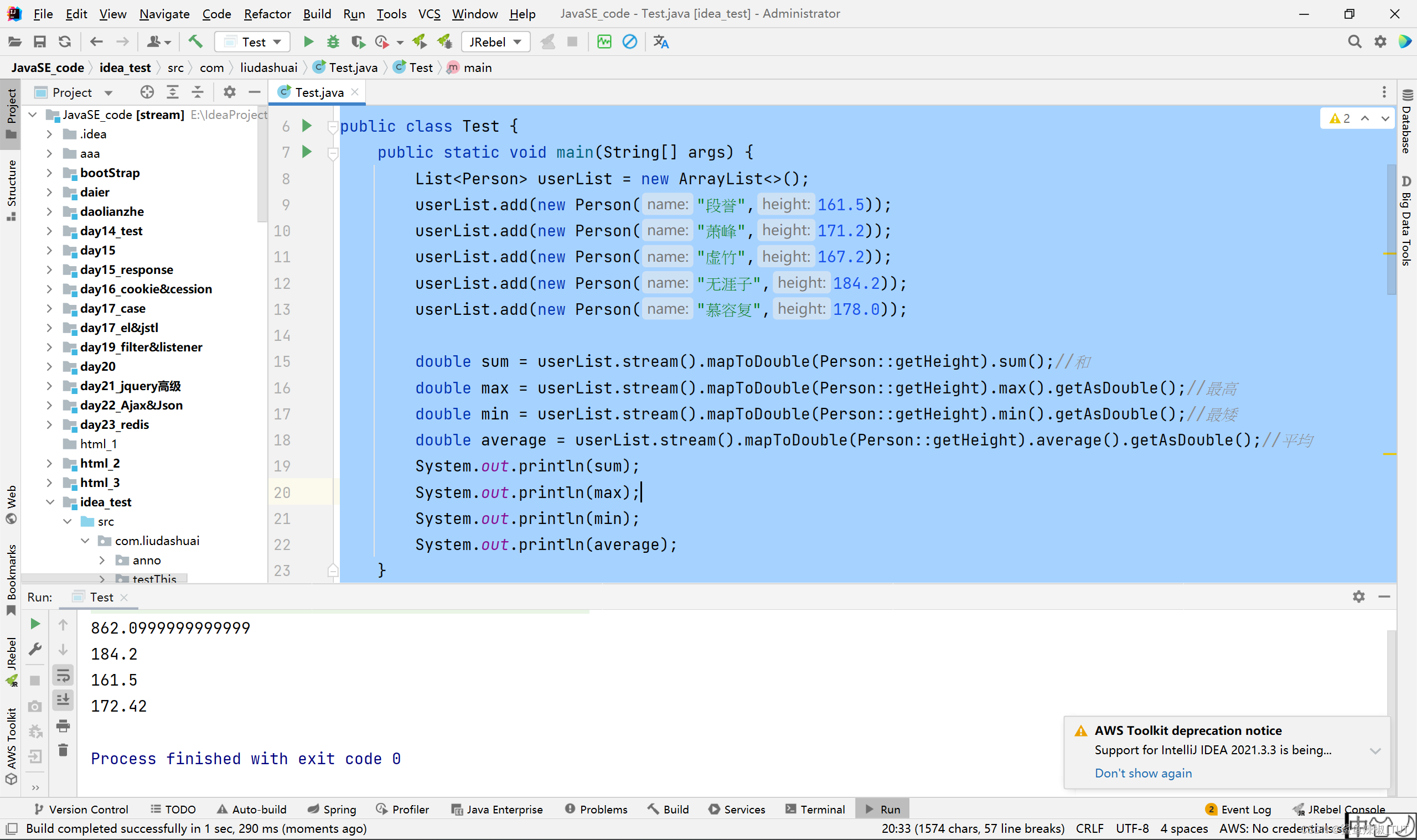Java Stream 的常用API
Java Stream 的常用API
遍历(forEach)
package com.liudashuai;import java.util.ArrayList;
import java.util.List;public class Test {public static void main(String[] args) {List<Person> userList = new ArrayList<>();userList.add(new Person("段誉",25));userList.add(new Person("萧峰",40));userList.add(new Person("虚竹",30));userList.add(new Person("无涯子",100));userList.add(new Person("慕容复",35));userList.add(new Person("云中鹤",45));System.out.println(userList);System.out.println("---------------");userList.stream().forEach(u -> {u.setName("天龙八部-" + u.getName());});System.out.println(userList);}
}
class Person{private String name;private int age;public Person(String name, int age) {this.name = name;this.age = age;}public String getName() {return name;}public void setName(String name) {this.name = name;}public int getAge() {return age;}public void setAge(int age) {this.age = age;}@Overridepublic String toString() {return "Person{" +"name='" + name + '\'' +", age=" + age +'}';}
}
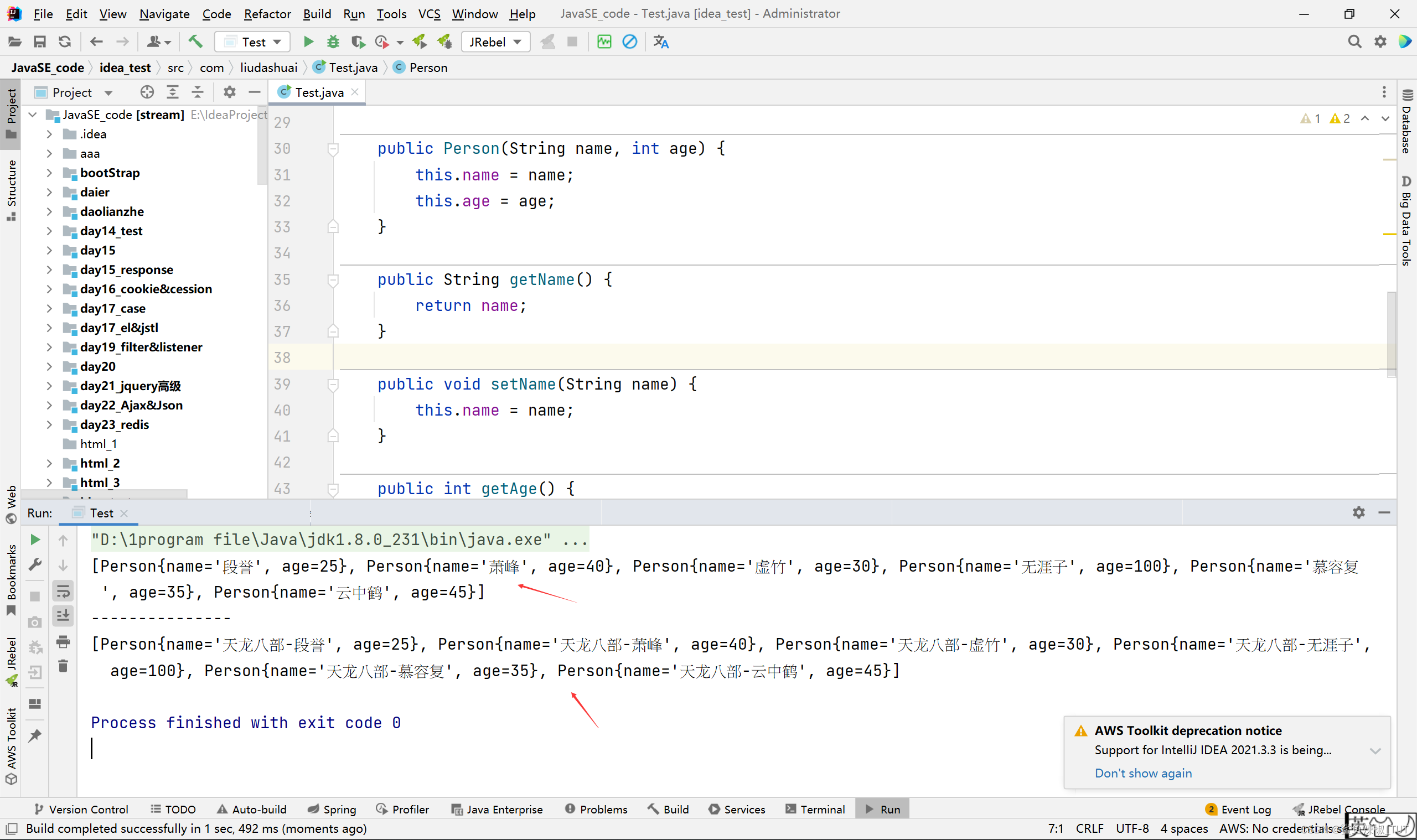
筛选(filter)
package com.liudashuai;import java.util.ArrayList;
import java.util.List;
import java.util.stream.Collectors;public class Test {public static void main(String[] args) {List<Person> userList = new ArrayList<>();userList.add(new Person("段誉",25));userList.add(new Person("萧峰",40));userList.add(new Person("虚竹",30));userList.add(new Person("无涯子",100));userList.add(new Person("慕容复",35));userList.add(new Person("云中鹤",45));List<Person> collect =userList.stream().filter(user -> (user.getAge() > 30 && user.getName().length() >2)).collect(Collectors.toList());System.out.println(collect);}
}
class Person{private String name;private int age;public Person(String name, int age) {this.name = name;this.age = age;}public String getName() {return name;}public void setName(String name) {this.name = name;}public int getAge() {return age;}public void setAge(int age) {this.age = age;}@Overridepublic String toString() {return "Person{" +"name='" + name + '\'' +", age=" + age +'}';}
}

查找(findAny/findFirst)
package com.liudashuai;import java.util.ArrayList;
import java.util.List;public class Test {public static void main(String[] args) {List<Person> userList = new ArrayList<>();userList.add(new Person("段誉",25));userList.add(new Person("萧峰",41));userList.add(new Person("萧峰",42));userList.add(new Person("萧峰",43));userList.add(new Person("虚竹",30));userList.add(new Person("无涯子",100));userList.add(new Person("慕容复",35));userList.add(new Person("云中鹤",45));Person user = userList.stream().filter(u -> u.getName().equals("阿紫")).findAny().orElse(new Person("无",0));System.out.println(user);Person user1 = userList.stream().filter(u -> u.getName().equals("阿紫")).findAny().orElse(null);System.out.println(user1);Person user2 = userList.stream().filter(u -> u.getName().equals("萧峰")).findAny().orElse(null);System.out.println(user2);Person user3 = userList.stream().filter(u -> u.getName().equals("萧峰")).findFirst().orElse(null);System.out.println(user3);}
}
class Person{private String name;private int age;public Person(String name, int age) {this.name = name;this.age = age;}public String getName() {return name;}public void setName(String name) {this.name = name;}public int getAge() {return age;}public void setAge(int age) {this.age = age;}@Overridepublic String toString() {return "Person{" +"name='" + name + '\'' +", age=" + age +'}';}
}
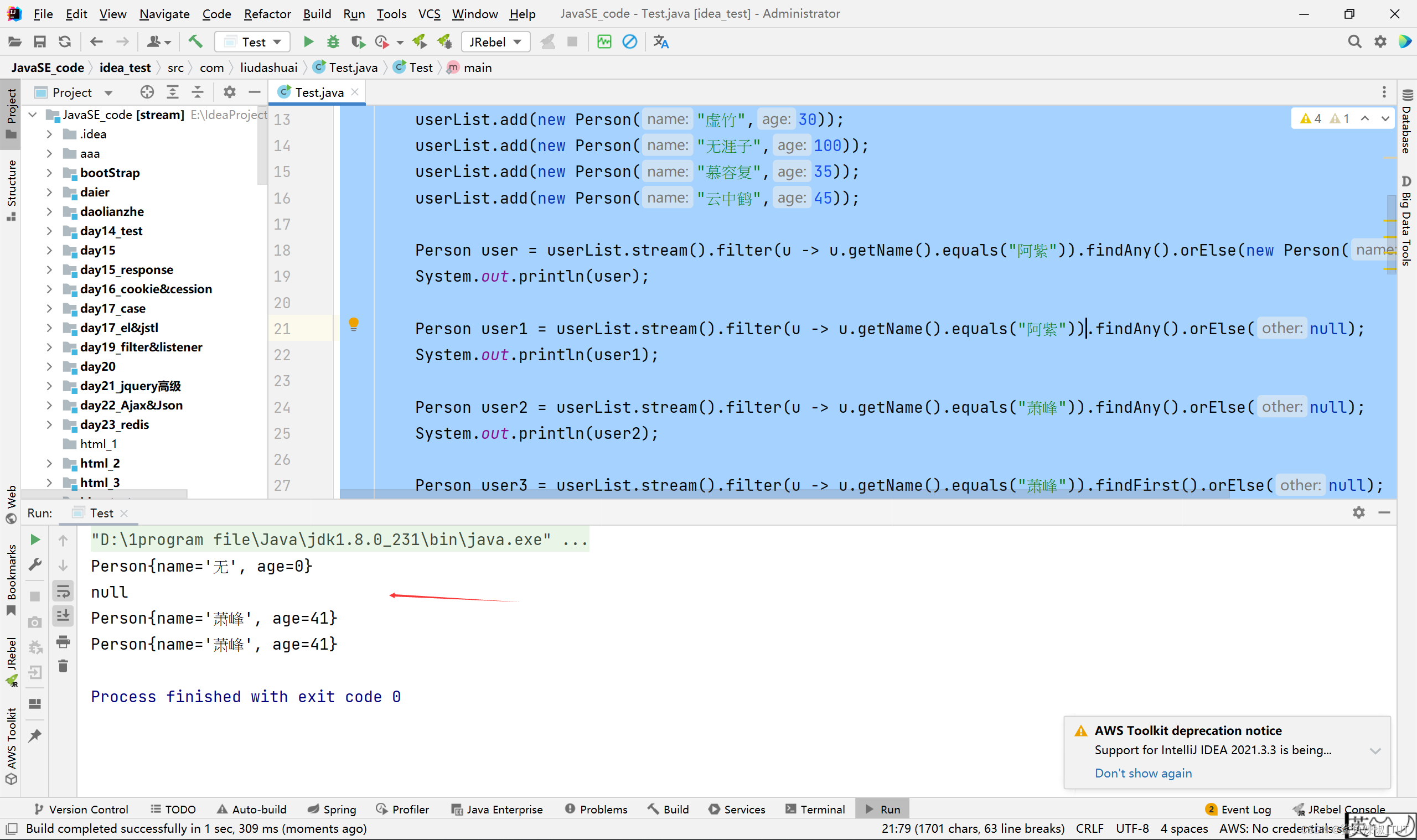
- findFirst() 方法根据命名,我们可以大致知道是获取Optional流中的第一个元素。
- findAny() 方法是获取Optional 流中任意一个,存在随机性,其实这里也是获取元素中的第一个,因为是并行流。
注意:在串行流中,findFirst和findAny返回同样的结果;但在并行流中,由于多个线程同时处理,findFirst可能会返回处理结果中的第一个元素,而findAny会返回最先处理完的元素。所以并行流里面使用findAny会更高效。这里并行下findFirst可能返回的不是第一个符合条件的元素吗?我不知道,但是,不重要,因为用得场景不多,因为多线程下,谁是处理结果中的第一个元素一般不重要,因为谁都可能是第一个,所以这里我不去了解findFirst是否可能返回的不是第一个符合条件的元素了。
总之就是串行流下,findFirst和findAny结果一样,并行流下,findAny效率更高,且并行流一般不在意谁是第一个,所以我建议平时使用findAny。
.orElse(null)表示如果一个都没找到返回null。
orElse()中可以塞默认值。如果找不到就会返回orElse中你自己设置的默认值。比如:上面的.orElse(new Person(“无”,0))
转换/去重(map/distinct)
package com.liudashuai;import java.util.ArrayList;
import java.util.List;
import java.util.stream.Collectors;public class Test {public static void main(String[] args) {List<Person> userList = new ArrayList<>();userList.add(new Person("段誉",25));userList.add(new Person("萧峰",41));userList.add(new Person("萧峰",42));userList.add(new Person("虚竹",30));userList.add(new Person("无涯子",100));userList.add(new Person("慕容复",35));userList.add(new Person("云中鹤",45));List<String> nameList = userList.stream().map(Person::getName).collect(Collectors.toList());System.out.println(nameList);List<String> nameList2 = userList.stream().map(Person::getName).distinct().collect(Collectors.toList());System.out.println(nameList2);}
}
class Person{private String name;private int age;public Person(String name, int age) {this.name = name;this.age = age;}public String getName() {return name;}public void setName(String name) {this.name = name;}public int getAge() {return age;}public void setAge(int age) {this.age = age;}@Overridepublic String toString() {return "Person{" +"name='" + name + '\'' +", age=" + age +'}';}
}
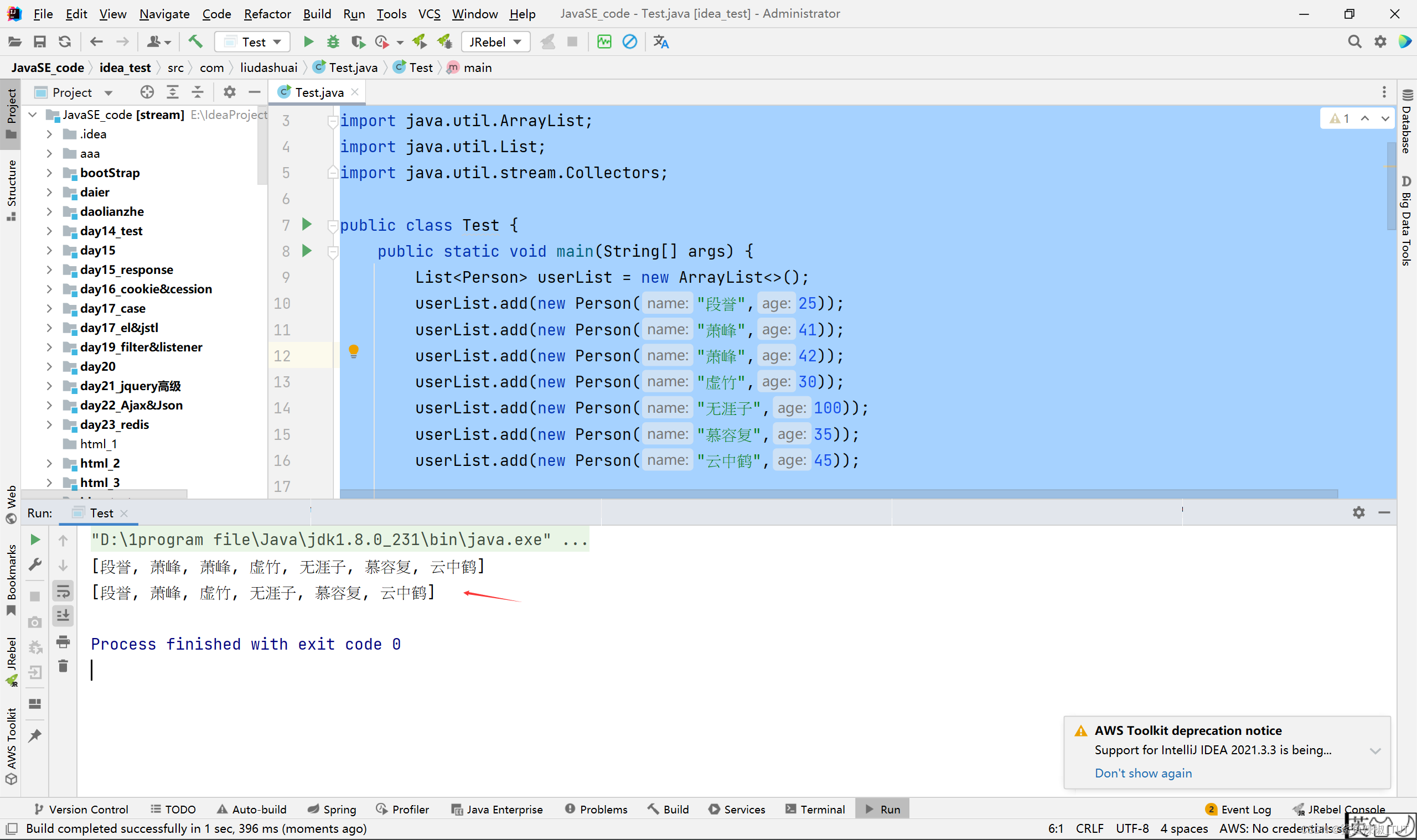
map的作用:是将输入一种类型,转化为另一种类型,通俗来说:就是将输入类型变成另一个类型。
跳过(limit/skip)
package com.liudashuai;import java.util.ArrayList;
import java.util.List;
import java.util.stream.Collectors;public class Test {public static void main(String[] args) {List<Person> userList = new ArrayList<>();userList.add(new Person("段誉",25));userList.add(new Person("萧峰",41));userList.add(new Person("虚竹",30));userList.add(new Person("无涯子",100));userList.add(new Person("慕容复1",35));userList.add(new Person("慕容复2",35));userList.add(new Person("慕容复3",35));//跳过第一个List<Person> collect = userList.stream().skip(1).collect(Collectors.toList());System.out.println(collect);//只输出前两个元素List<Person> collect2 = userList.stream().limit(2).collect(Collectors.toList());System.out.println(collect2);//跳过前3个元素,然后输出3个元素。可以代替sql中的limit。List<Person> collect3 = userList.stream().skip(3).limit(3).collect(Collectors.toList());System.out.println(collect3);}
}
class Person{private String name;private int age;public Person(String name, int age) {this.name = name;this.age = age;}public String getName() {return name;}public void setName(String name) {this.name = name;}public int getAge() {return age;}public void setAge(int age) {this.age = age;}@Overridepublic String toString() {return "Person{" +"name='" + name + '\'' +", age=" + age +'}';}
}

最大值/最小值/平均值(reduce)
package com.liudashuai;import java.util.ArrayList;
import java.util.List;
import java.util.Optional;
import java.util.stream.Collectors;public class Test {public static void main(String[] args) {List<Person> userList = new ArrayList<>();userList.add(new Person("段誉",25));userList.add(new Person("萧峰",41));userList.add(new Person("虚竹",30));userList.add(new Person("无涯子",100));userList.add(new Person("慕容复",35));System.out.println("求和");Integer sum1 = userList.stream().map(Person::getAge).reduce(0, Integer::sum);System.out.println(sum1);int sum2 = userList.stream().mapToInt(Person::getAge).sum();System.out.println(sum2);Integer sum3 = userList.stream().collect(Collectors.summingInt(Person::getAge));System.out.println(sum3);System.out.println("最大值");Optional<Integer> max1 = userList.stream().map(Person::getAge).collect(Collectors.toList()).stream().reduce((v1, v2) -> v1 > v2 ? v1 : v2);System.out.println(max1.get());Optional<Integer> max2 = userList.stream().map(Person::getAge).collect(Collectors.toList()).stream().reduce(Integer::max);System.out.println(max2.get());int max3 = userList.stream().mapToInt(Person::getAge).max().getAsInt();System.out.println(max3);System.out.println("最小值");Optional<Integer> min = userList.stream().map(Person::getAge).collect(Collectors.toList()).stream().reduce(Integer::min);System.out.println(min.get());int min2 = userList.stream().mapToInt(Person::getAge).min().getAsInt();System.out.println(min2);System.out.println("平均值");Double averaging1 = userList.stream().collect(Collectors.averagingDouble(Person::getAge));System.out.println(averaging1);double averaging2 = userList.stream().mapToInt(Person::getAge).average().getAsDouble();System.out.println(averaging2);}
}
class Person{private String name;private int age;public Person(String name, int age) {this.name = name;this.age = age;}public String getName() {return name;}public void setName(String name) {this.name = name;}public int getAge() {return age;}public void setAge(int age) {this.age = age;}@Overridepublic String toString() {return "Person{" +"name='" + name + '\'' +", age=" + age +'}';}
}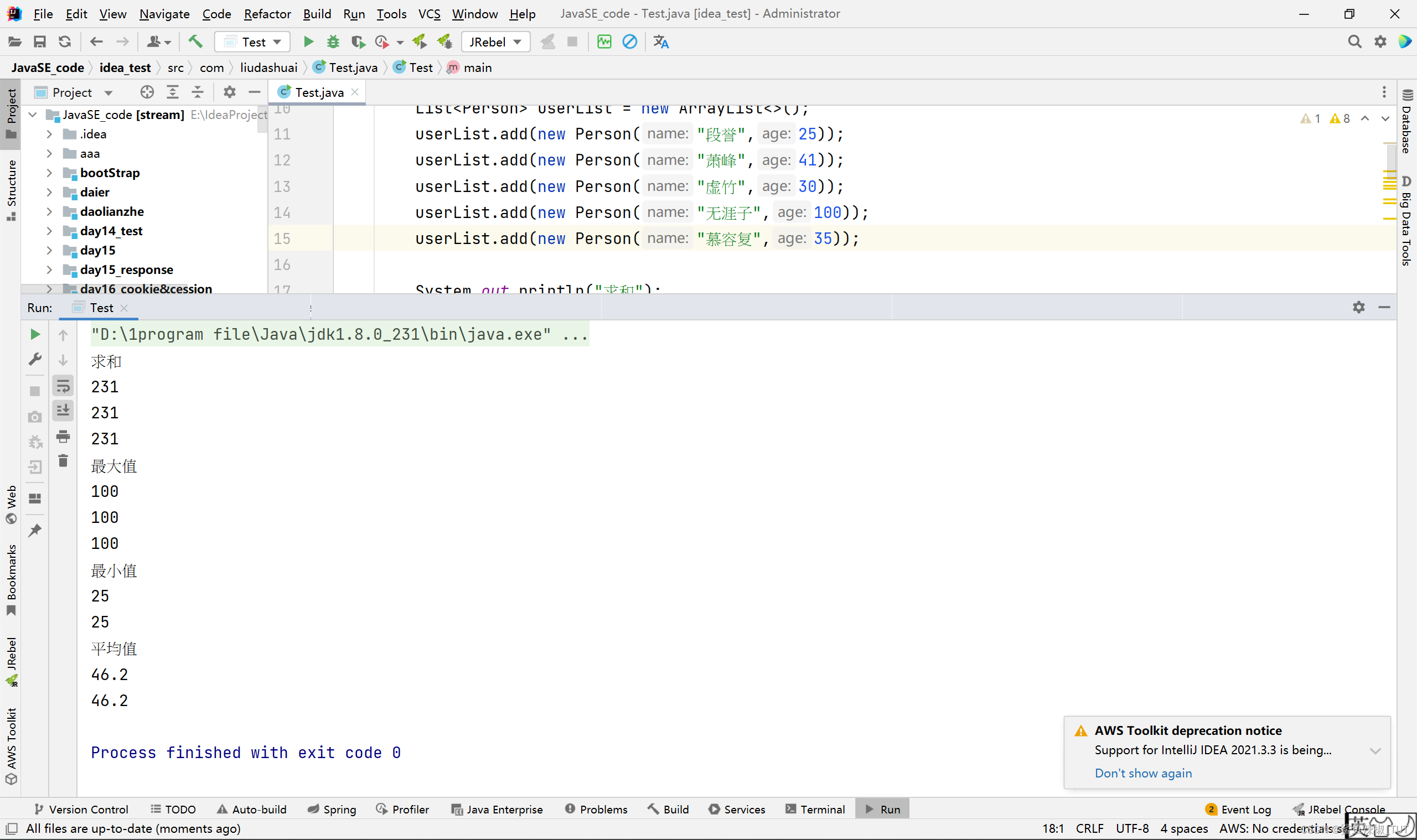
mapToInt是 Stream API中一个非常有用的方法。它的主要作用是将一个 Stream 转换成一个IntStream,使得可以更加方便地对数字流进行处理。
IntStream中的一些常用方法如下:
- sum()
- max()
- min()
- average()
这些方法上面案例里面也有演示。
如果要操作的元素不是int,是double,我们也可以用mapToDouble也行。
package com.liudashuai;import java.util.ArrayList; import java.util.List;public class Test {public static void main(String[] args) {List<Person> userList = new ArrayList<>();userList.add(new Person("段誉",161.5));userList.add(new Person("萧峰",171.2));userList.add(new Person("虚竹",167.2));userList.add(new Person("无涯子",184.2));userList.add(new Person("慕容复",178.0));double sum = userList.stream().mapToDouble(Person::getHeight).sum();//和double max = userList.stream().mapToDouble(Person::getHeight).max().getAsDouble();//最高double min = userList.stream().mapToDouble(Person::getHeight).min().getAsDouble();//最矮double average = userList.stream().mapToDouble(Person::getHeight).average().getAsDouble();//平均System.out.println(sum);System.out.println(max);System.out.println(min);System.out.println(average);} } class Person{private String name;private double height;public Person(String name, double height) {this.name = name;this.height = height;}public String getName() {return name;}public void setName(String name) {this.name = name;}public double getHeight() {return height;}public void setHeight(double height) {this.height = height;}@Overridepublic String toString() {return "Person{" +"name='" + name + '\'' +", height=" + height +'}';} }
统计(count/counting)
package com.liudashuai;import java.util.ArrayList;
import java.util.List;
import java.util.stream.Collectors;public class Test {public static void main(String[] args) {List<Person> userList = new ArrayList<>();userList.add(new Person("段誉",25));userList.add(new Person("萧峰",41));userList.add(new Person("虚竹",30));userList.add(new Person("无涯子",100));userList.add(new Person("虚竹",30));userList.add(new Person("慕容复",35));Long collect = userList.stream().filter(p -> p.getName() == "虚竹").collect(Collectors.counting());System.out.println(collect);long count = userList.stream().filter(p -> p.getAge() >= 50).count();System.out.println(count);}
}
class Person{private String name;private int age;public Person(String name, int age) {this.name = name;this.age = age;}public String getName() {return name;}public void setName(String name) {this.name = name;}public int getAge() {return age;}public void setAge(int age) {this.age = age;}@Overridepublic String toString() {return "Person{" +"name='" + name + '\'' +", age=" + age +'}';}
}
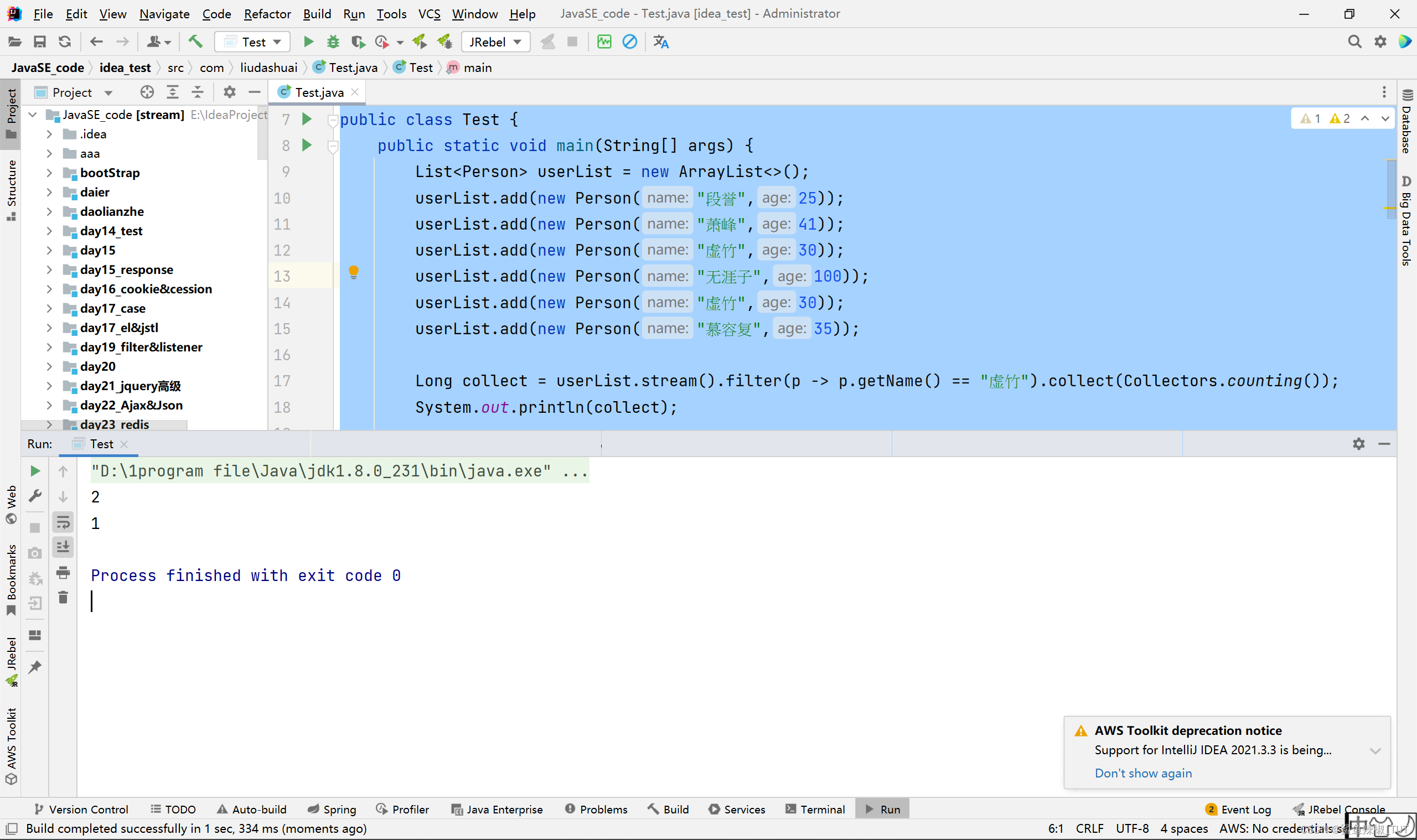
排序(sorted)
package com.liudashuai;import java.util.ArrayList;
import java.util.Comparator;
import java.util.List;
import java.util.stream.Collectors;public class Test {public static void main(String[] args) {List<Person> userList = new ArrayList<>();userList.add(new Person("1",25));userList.add(new Person("2",41));userList.add(new Person("33",30));userList.add(new Person("11",100));userList.add(new Person("55",30));userList.add(new Person("22",35));List<Person> collect =userList.stream().sorted(Comparator.comparing(Person::getAge).reversed()).collect(Collectors.toList());System.out.println(collect);List<Person> collect2 =userList.stream().sorted(Comparator.comparing(Person::getAge)).collect(Collectors.toList());System.out.println(collect2);List<Person> collect3 =userList.stream().sorted(Comparator.comparing(Person::getName)).collect(Collectors.toList());System.out.println(collect3);List<Person> collect4 = userList.stream().sorted((e1, e2) -> {return Integer.compare(Integer.parseInt(e1.getName()), Integer.parseInt(e2.getName()));}).collect(Collectors.toList());System.out.println(collect4);}
}
class Person{private String name;private int age;public Person(String name, int age) {this.name = name;this.age = age;}public String getName() {return name;}public void setName(String name) {this.name = name;}public int getAge() {return age;}public void setAge(int age) {this.age = age;}@Overridepublic String toString() {return "Person{" +"name='" + name + '\'' +", age=" + age +'}';}
}
